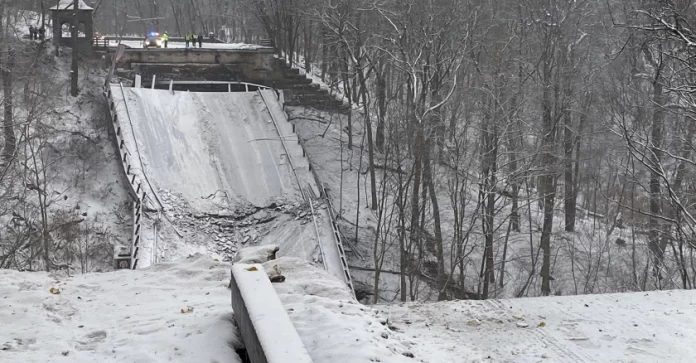Pennsylvania state Rep. Dan Frankel walks his dog in Pittsburgh’s Frick Park all the time, an oasis of cultivated wilderness on the edge of Pennsylvania’s second largest city.
Frankel and his wife would take their pooch to the dog park that lay in the shadow of the Forbes Avenue bridge, which suddenly collapsed Friday morning as President Joe Biden was about to arrive to talk about infrastructure spending.
“It was visually a stunning thing to see, and mind boggling to process,” says Frankel, who has served in the Pennsylvania Legislature for 24 years. “But it shouldn’t be surprising that something like that happened in our community, given the lack of investment that we’ve seen over the years in our aging infrastructure.”
As a storm swept the region, the bridge collapsed due to heavy snowfall. A Port Authority bus and several cars were taken down with it, and 10 people were reported injured. President Biden detoured from his arranged schedule to visit the site, promising that the city’s many deteriorated bridges would soon be seen to.
As Biden stared at the scene of devastation in apparent awe, he acknowledged that Pittsburgh is reputed to have more bridges than any city in the world. “And we’re going to fix them all,” he said, according to Reuters. (Allegheny County, where Pittsburgh is located, contains around 1,600 state and locally controlled bridges.)
The infrastructure law that President Biden passed last year contains $27.5 billion specifically for the construction and repair of bridges. The law distributes the funds proportionally according to the scale of need, so Pennsylvania will get the third most of any state despite being fifth largest by population. The first $327 million was distributed to the state just two weeks ago.
There are over 3,300 bridges in a poor state of repair across Pennsylvania, and as a result the state is getting $1.6 billion. The Pittsburgh Post-Gazette reported that Allegheny County has the largest number of bridges in poor condition in the state, and that 20 percent of locally controlled bridges — like the Forbes Avenue structure — are in poor shape.
Nationwide, the country has nearly 44,000 bridges in poor condition, according to the U.S. Department of Transportation.
The Forbes Avenue bridge was rated as being in poor condition for over a decade, and a widely circulated photograph from 2018 on Twitter showed bad deterioration and patchy maintenance.
Approximately 14,000 people a day drove over the Forbes Avenue bridge, not to mention the dog walkers and other park users who unwittingly played beneath it. The last time it was inspected, six months ago, it was still reported in bad shape but there was no indication it was in danger of collapsing.
Pennsylvania’s track record of infrastructure spending is weak. (The White House described “a systemic lack of investment” in a report card it issued for the state last year.) In 2013, a transportation funding bill, backed by a Republican governor, passed only after numerous attempts by conservative Republicans to scuttle it. Despite this hard-won victory, the state still did not provide nearly enough to support its infrastructure needs.
That’s because Pennsylvania has been underfunding all kinds of transportation infrastructure. Unlike most states, it hasn’t even been adding to highway miles and actually had fewer lane miles in 2019 (88,261) than in 2000 (88,483). According to Urban Institute researcher Yonah Freemark, between 1980 and 2019 Pennsylvania only increased its expressway lane miles by 1.8 percent. The median American state in that time expanded its total expressway arterial and collector lane miles by 12.3 percent. Public transit, needless to say, is also in bad shape.
“It’s like trying to put your finger in the dike,” says Frankel about funding Pennsylvania’s infrastructure needs. “Where do you go first, when you have such limited resources? Unfortunately, it’s a guessing game to decide where you’re going to put your limited resources at the time.”
Although the funds from Biden’s infrastructure law are distributed by the federal authorities, the state government will control how it is actually spent. While the administration is advising states to spend on repair, they are also allowed to build new bridges.

The Forbes Avenue bridge will no doubt be high on the agenda. Police and fire officials are already predicting that the loss of the infrastructure could double response times, which could have devastating results in case of emergency.
“It’s not just an economic issue, it’s a public safety issue,” says Frankel. “Buses, EMS, police and fire are going to have a much more difficult time getting around. It puts an exclamation point on what we need to do around infrastructure as elected officials.”
Originally published by Governing. Republished with permission.












[…] Click this link for the original source of this article. Author: Jake Blumgart […]